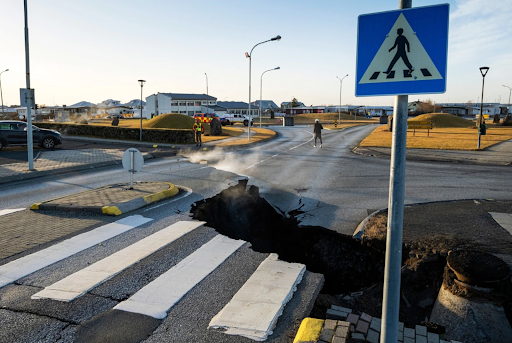|
Will the town of Grandavik be spared from this volcanic activity? Image c/o NBC News By Lillian La Salle Associate Editor As cracks widen into chasms destroying Icelandic infrastructure and sinkholes swallow up property in the small town of Grindavik, some scientists remain hopeful that the community will be spared from the impending volcanic eruption.
Iceland, a country of less than 400,000 people has been at the mercy of volcanic activity for years and even stands between two tectonic plates with a considerable amount of seismic activity. According to the Complete Guide to Iceland, the country has seen an uptick in volcanic activity, with the Fagradalsfjall volcano erupting in 2021 and 2022 after not erupting for 6,000 years. According to The New York Times, the new volcanic activity is 40 miles away from the small town of Grindavik, home to a little over 3,000 Icelandic citizens. PBS said City officials ordered the evacuation of citizens on November 14th and a week later citizens were allowed to return to secure their key possessions. Icelandic resident Ingibjorn Gretarsdottir says in an interview while waiting to reenter the town, “The earth has collapsed about one meter or something, so the lava is under our house. We don't know if we're going to have a home or what.” Meanwhile, other residents are quickly packing as much of their lives into their cars to escape to safety, with some residents packing their business supplies in with their familial belongings to make sure they still have a livelihood. It is unknown the exact effects the eruption will have on the town of Grindavik, but scientists explain to PBS that the eruption of magma may come from the fissures that have been evolving and expanding in the ground throughout the town, spreading the volcanic effects across a wider range. Already Jon Thor Viglundsson, a spokesman for Iceland’s Department of Civil Protection and Emergency Management, explained to the New York Times that the sewage systems are under great stress with the magma causing the lines to rupture. Mr. Viglundsson adds that the eruption also poses a large threat to the infrastructure of the town, putting thousands at risk. On the more hopeful side, The Times and PBS have secured information that the seismic activity causing earthquakes has been steadily declining. The Times includes the previous amount of seismic activity, which reached over 1,000 earthquakes all across the Reykjanes Peninsula in the southwestern part of Iceland in only a 24 hour period. Since last month when the earthquakes reached their peak, Iceland has seen over 10,000 earthquakes all across the peninsula. In the past week seismic activity is less frequent and has a lower magnitude than before, giving hope to Iceland that their towns will be safe. Kristin Jonsdottir, head of Iceland's volcanoes department, explained to PBS that, “Every day, what we're seeing is a decline in the rate of earthquakes and also in the rate of energy release from the earthquakes.” However, she explains this decline in seismic activity does not mean that an eruption will not occur. Iceland Meteorology Officer Benedikt Ofeigsson says that, “If an eruption will occur, it's probably within days, rather than weeks.” Citizens question whether they will be able to return to their homes in Grindavik at all, and Icelandic Prime Minister Katrin Jakobsdottir is working to ensure housing and salaries for the citizens who are displaced by the danger of eruption. The town is also working tirelessly to protect their powerplant form the scortching magma that could melt it down to nothing. The Times explains this power plant provides energy and hot water for over 30,000 people and was expected to take 30 days to complete. However, a PBS interview with Vidir Reynisson, Director General of Icelandic Civil Defense found that, “We are a little bit ahead of schedule...even if we would have an eruption in the dike at this moment…we would at least to delay the lava flow to the power plant.” Although the displacement of thousands is causing great distress among Iceland and numerous other countries throughout the world, Forbes explains the global effects of this eruption will not be as widespread as the Eyjafjallajökull eruption of 2010 which delayed 100,000 transatlantic flights due to the substantial amount of volcanic ash in air circulation. The impending eruption will have lasting effects on the people Grandavik, and all of Iceland will suffer the impacts of earthquakes that will ensue with this volcanic activity. Thankfully Icelandic Officials are acting quickly and efficiently to protect their citizens and their livelihoods from the volcanic activity that threatens their communities.
0 Comments
Leave a Reply. |
StaffMadison Sciba '24, Archives
November 2023
Categories |


 RSS Feed
RSS Feed